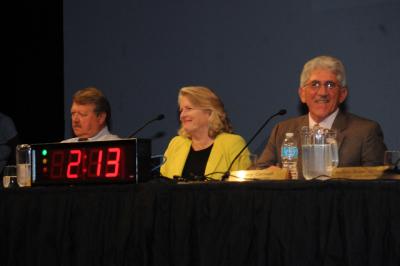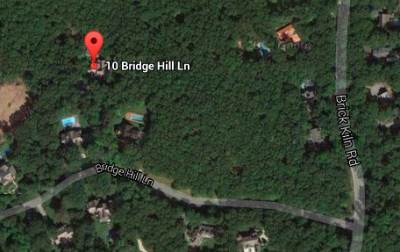Aircraft Noise Sets Off A Primal Scream
Aircraft Noise Sets Off A Primal Scream

Three hundred and eighty-five people from both the North and South Forks made plenty of noise last week at an East Hampton Town Board forum on aircraft noise. All but one of the 53 speakers at the meeting, which was aired live on cable in the East End towns, asked the board to reject Federal Aviation Administration grants and impose restrictions, such as curfews and a limit on the number of flights, that would reduce airplane and helicopter noise across the region.
The board has been collecting data to submit to the F.A.A., which must give its permission before a municipality can enact such restrictions.
The acceptance of federal money comes with strings attached — “grant assurances” that guarantee a degree of F.A.A. control over an airport. Several such are set to expire at the end of this year, and the town board has held off on seeking new grants. The previous board had taken the initial steps to accept new federal grants.
“This right, no other town board has had,” Frank Dalene, founder of East Hampton Helicopter Noise and a co-founder of East Hampton’s Quiet Skies Coalition, said of what many called an opportunity, come January, to make meaningful changes aimed at noise reduction.
The generally polite audience cheered and applauded Mr. Dalene after he declared that “people are mad as hell and we are not going to take it anymore.”
“You can make it happen,” Margaret Skabry of Peconic told the town board. “You have a golden opportunity. Be the heroes.”
“This is a watershed moment for the aircraft noise-abatement movement. The people have spoken,” Kathleen Cunningham, Quiet Skies Coalition director, wrote in a letter to the editor this week.
The Southampton, Shelter Island, and Southold Town Boards, and the North Haven Village Board have all passed recent resolutions asking East Hampton not to accept new F.A.A. grants, and to address airport noise. Twenty-one elected officials attended last week’s meeting, which came on the heels of similar forums in Southold, Bridgehampton, and on Shelter Island.
“We’re on fire on this issue; we’re not going to let go of it,” vowed Shelter Island Supervisor James Dougherty.
“It’s an issue that transcends all bor ders,” said Southampton Town Supervisor Anna Throne-Holst. “How inspired we are by the difference [from] what we used to see,” she added, speaking of the previous East Hampton administration.
“We did try the voluntary compliance,” said Ms. Throne-Holst. (The airport management has been asking pilots to follow certain noise-abatement procedures on a volunteer basis.) “We know for a fact that didn’t work.”
Numerous speakers said East Hampton Airport should be, as it once was, a small recreational facility, rather than a base for commercial interests, as it has become. Helicopter ride-sharing services, easily accessible through an app, began this summer, during which airport traffic went up by more than 40 percent.
Officials and residents alike offered to back East Hampton Town in the face of potential lawsuits. The Eastern Region Helicopter Council and an aviation group called Friends of the East Hampton Airport have mounted an aggressive media and industry campaign to paint the noise-reduction efforts as an attempt to close the airport altogether.
Friends of the East Hampton Airport, in a recent newsletter, promised to sue if town officials did not meet with their representatives by the first week of September. No reply was received by press time to an email message to the group, which had rallied its members to attend last week’s meeting, promising “robust and aggressive counterarguments and a public relations strategy.” No one spoke on behalf of the group at the forum, however.
State Assemblyman Fred W. Thiele Jr. suggested that those opposed to noise-reduction efforts “have narrower, self-economic interests than the general interest of the people of the East End.”
Christine Scalera, a Southampton Town councilwoman, said there was a “blatant disregard by certain people of the local population here . . . those who choose to profit, to the detriment of the residents.”
“The North Fork bears the brunt of the noise,” said Suffolk Legislator Al Krupski. And, he said, “absolutely, there’s no benefit at all.”
Adjusting aircraft routes only shifts the problem, according to many speakers. The solution, said Jim Colligan of Shelter Island, “is to significantly reduce the volume of flights into the airport.” The helicopter companies that are opposing restrictions, he said, “have underestimated the will of the people.” The issue “has galvanized the East End community like no other.”
“I know that the greedy aviation interests will probably file a lawsuit on Jan. 1 or 2,” said Patricia Currie of Sag Harbor. But, she said, “to the pilots in the room and the commercial operators who are making our lives hell . . . it is time for you to leave. Take your money and fly away home.”
Commercial interests are profiting, she charged, at the price of “our health, our well-being, the pollution of our environment, and the total destruction of our peace and quiet.”
Mr. Thiele acknowledged the airport’s role in the regional economy. “But,” he said, “the intensity of use has grown to the point where it is having an adverse impact.” East End residents, he said, have repeatedly affirmed their desire to protect the character and quality of life of their towns, for example by voting for the community preservation fund tax.
Barry Raebeck, the Quiet Skies co-founder, discussed East Hampton’s long resistance to overdevelopment. “The assault from the air is perhaps the most invasive and aggressive of all,” he said.
“Science tells us that aircraft noise is extremely disturbing to animals,” including humans, said Jim Mathews of East Hampton, a professor of psychology and neural science at New York University. Numerous studies have shown, he said, that recurring aircraft noise “is a truly biological disruptive behavior,” affecting, among other things, adult cardiovascular health and children’s attention spans.
David Lichtenstein of Shelter Island, a clinical psychologist, concurred. “It’s not simply a quality-of-life issue or an economic issue, but a health issue to eliminate the helicopters,” he said. “Sleep disturbance has a demonstrable effect on immune response.”
Others spoke of near-misses in the air and safety concerns, particularly regarding helicopters. “Please consider the safety issue before we have a disaster,” said Henry Rossi of North Haven. “I think you have more traffic than this airport can handle.”
Although noise-reduction advocates have repeatedly insisted that aviation interests are wrong in saying there is an agenda to close the airport altogether, Peter Wolf warned that if reasonable noise restrictions are not adopted, “the next step will likely be a more strident effort to close the airport.”
Mr. Wolf, chairman of the East Hampton Village Preservation Society’s airport noise committee and a member of the town board’s committee, was applauded. He and Ken Lipper had written to their village neighbors, 300 of whom, he said, had responded favorably, in support of airport use restrictions to curb noise.
“As I see it, we only really have two choices here: shut it up, or shut it down,” said Tom MacNiven, vice chairman of the town’s airport noise committee.
Several people spoke emotionally of frustration, stretching over years, at having to live with disturbing aircraft noise, and of calling in complaints to the airport noise hotline to no effect.
“I just cannot call anymore; the stress level — I get so angry,” said Tom Maguire of Cutchogue. “I’m so sick of this; it’s horrible,” said Amy Greenberg of Mattituck.
“No matter where I go, I cannot escape the pounding noise,” said Teresa McCaski. “We on the North Fork have been inundated, all to accommodate the wealthy.”
“Complaint fatigue is a real issue,” said Ms. Cunningham, the Quiet Skies Coalition director.
Richard Prins suggested that the town encourage the Long Island Rail Road to provide fast, luxury rail service from Manhattan to the East End. “If they want to spend $500 to get here, then they can get here in a quiet way,” he said.
Tony Lambert from Bridgehampton was the sole speaker who did not see aviation noise as a problem. “Me personally, I’m going to tell you right now, I don’t care,” he said.
The East Hampton Town Board’s airport liaison, Councilwoman Kathee Burke-Gonzalez, said the board was “absolutely committed to addressing the noise problem and finding a lawful solution.” However, she warned those assembled to “be realistic,” as the town must follow “a complex web of laws, procedures, and requirements” throughout the process.
In the coming weeks, Ms. Burke-Gonzalez said, the board will prepare a detailed outline and timetable “for adopting appropriate rules to address the noise problem.”







